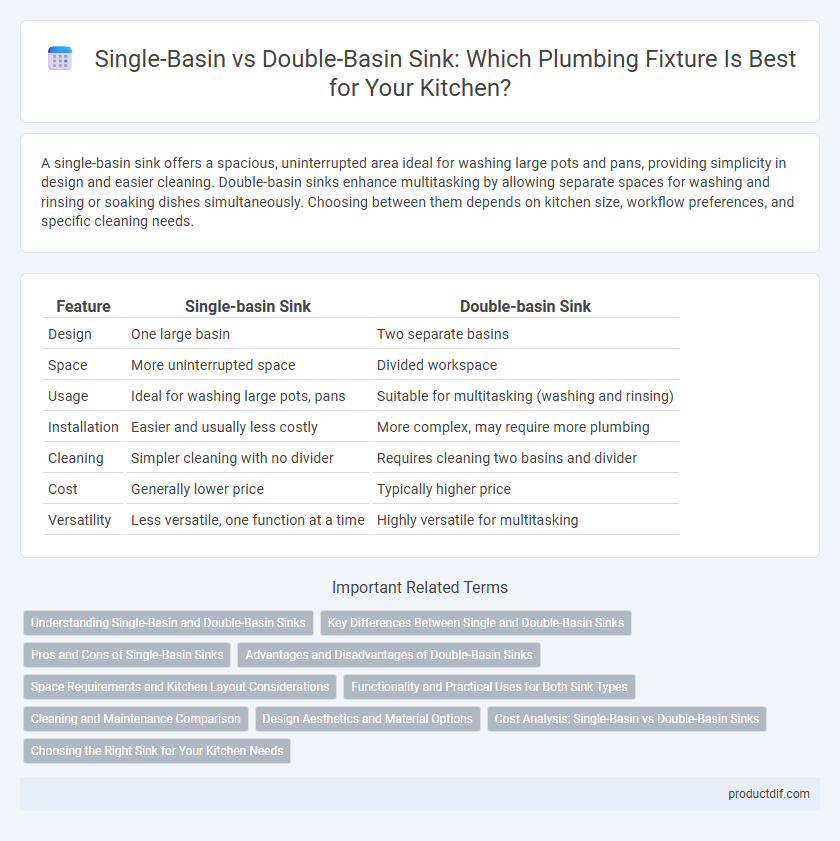A single-basin sink offers a spacious, uninterrupted area ideal for washing large pots and pans, providing simplicity in design and easier cleaning. Double-basin sinks enhance multitasking by allowing separate spaces for washing and rinsing or soaking dishes simultaneously. Choosing between them depends on kitchen size, workflow preferences, and specific cleaning needs.
Table of Comparison
| Feature | Single-basin Sink | Double-basin Sink |
|---|---|---|
| Design | One large basin | Two separate basins |
| Space | More uninterrupted space | Divided workspace |
| Usage | Ideal for washing large pots, pans | Suitable for multitasking (washing and rinsing) |
| Installation | Easier and usually less costly | More complex, may require more plumbing |
| Cleaning | Simpler cleaning with no divider | Requires cleaning two basins and divider |
| Cost | Generally lower price | Typically higher price |
| Versatility | Less versatile, one function at a time | Highly versatile for multitasking |
Understanding Single-Basin and Double-Basin Sinks
Single-basin sinks offer a large uninterrupted space ideal for washing oversized pots and pans, enhancing efficiency in kitchens with limited countertop area. Double-basin sinks feature two separate compartments, enabling multitasking such as washing dishes in one basin while rinsing or soaking in the other. Choosing between single-basin and double-basin sinks depends on kitchen workflow, available space, and specific culinary needs.
Key Differences Between Single and Double-Basin Sinks
Single-basin sinks offer a large uninterrupted space ideal for washing oversized pots and pans, while double-basin sinks provide flexibility with two separate compartments allowing simultaneous tasks such as washing and rinsing. Single-basin sinks typically require less counter space and have a simpler installation process, whereas double-basin sinks often accommodate accessories like cutting boards and drying racks between the basins. Material options for both types include stainless steel, porcelain, and composite granite, with design choices influencing kitchen workflow efficiency and aesthetic preference.
Pros and Cons of Single-Basin Sinks
Single-basin sinks offer more space for washing large pots, pans, and baking sheets, making them ideal for heavy-duty kitchen tasks. They are easier to clean due to the absence of a divider, which reduces grime buildup and simplifies maintenance. However, single-basin sinks may lack the versatility of double-basin sinks, making multitasking, such as washing dishes while rinsing vegetables, more challenging.
Advantages and Disadvantages of Double-Basin Sinks
Double-basin sinks offer enhanced flexibility by allowing users to separate tasks, such as washing dishes in one basin while rinsing in the other, improving kitchen efficiency. These sinks can conserve water when used properly but often require more counter space and may complicate installation due to additional plumbing connections. However, their design can limit the size of individual basins, potentially reducing usability for larger pots or pans.
Space Requirements and Kitchen Layout Considerations
Single-basin sinks require less counter space, making them ideal for compact kitchens or minimalist layouts, while double-basin sinks need more width and depth to accommodate two separate compartments. The choice affects kitchen workflow, as double-basin sinks allow simultaneous use for washing and rinsing, which demands thoughtful placement near dishwashers and prep areas. Space planning must consider plumbing connections and surrounding cabinetry to optimize both functionality and aesthetic balance in the kitchen design.
Functionality and Practical Uses for Both Sink Types
Single-basin sinks offer a large, uninterrupted space ideal for washing bulky pots and pans, making them highly functional for heavy-duty kitchen tasks. Double-basin sinks provide versatile functionality with separate compartments for multitasking, such as washing dishes in one basin while rinsing vegetables in the other. The choice between single-basin and double-basin sinks depends on kitchen size, user habits, and the need for simultaneous activities during meal preparation and cleanup.
Cleaning and Maintenance Comparison
Single-basin sinks offer easier cleaning with fewer crevices and a seamless design, reducing the buildup of grime and making maintenance straightforward. Double-basin sinks can trap food particles and soap residue in the divider and corners, requiring more frequent scrubbing and attention. Materials like stainless steel and composite granite improve durability and simplify routine cleaning for both types of sinks.
Design Aesthetics and Material Options
Single-basin sinks offer a sleek, minimalist design ideal for modern kitchens, often crafted from stainless steel, cast iron, or composite granite for durability and style. Double-basin sinks provide a more traditional look, with versatile configurations available in materials such as porcelain, fireclay, and stainless steel to complement various kitchen aesthetics. Material options for both types include finishes like matte, polished, or brushed, enhancing the visual appeal while maintaining functionality.
Cost Analysis: Single-Basin vs Double-Basin Sinks
Single-basin sinks generally have a lower upfront cost compared to double-basin sinks due to simpler manufacturing and installation requirements. Double-basin sinks can increase expenses by requiring more complex plumbing and additional space, which may raise both material and labor costs. While single-basin sinks offer cost efficiency, double-basin models provide enhanced functionality that may justify the higher investment depending on kitchen usage patterns.
Choosing the Right Sink for Your Kitchen Needs
Single-basin sinks offer a spacious, uninterrupted area ideal for washing large pots and pans or preparing food, making them suitable for open kitchen designs and multitasking. Double-basin sinks provide separate compartments, enhancing organization by allowing simultaneous washing and rinsing or segregating dirty dishes from clean ones, which is beneficial for busy kitchens with multiple users. Selecting the right sink depends on kitchen size, cooking habits, and personal preferences for efficiency and space management.
Single-basin Sink vs Double-basin Sink Infographic

 productdif.com
productdif.com